Advance Management Accounting Report on Coca-Cola HBC
VerifiedAdded on 2023/01/16
|20
|5276
|27
Report
AI Summary
This report comprehensively analyzes advanced management accounting principles, focusing on financial information, cost analysis, and their impact on organizational performance, using Coca-Cola HBC as a case study. The report is divided into three key sections: the first explores the purpose of developing and presenting financial information, emphasizing the needs of various stakeholders like managers, shareholders, investors, and the government. The second section evaluates management accounting techniques, including microeconomic techniques such as cost analysis, cost-volume-profit analysis, flexible budgeting, and cost variances, as well as absorption and marginal costing. The third section examines the impact of a changing business environment on management accounting, including internal and external factors, and offers recommendations. The report covers actual and standard costs, variance control, and the implications of different types of changes in the business environment. This report offers a thorough overview of the subject, including its practical application.
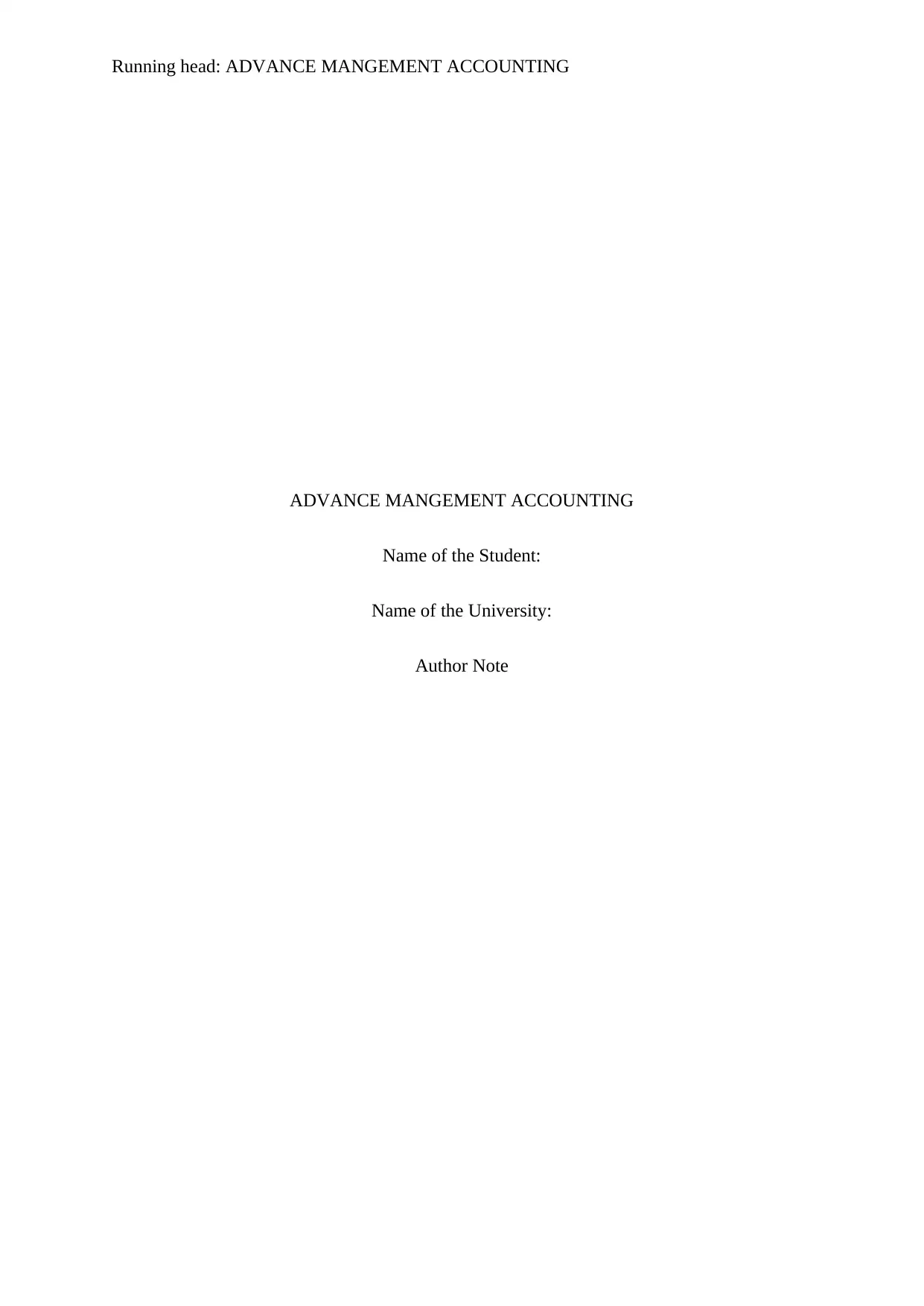
Running head: ADVANCE MANGEMENT ACCOUNTING
ADVANCE MANGEMENT ACCOUNTING
Name of the Student:
Name of the University:
Author Note
ADVANCE MANGEMENT ACCOUNTING
Name of the Student:
Name of the University:
Author Note
Paraphrase This Document
Need a fresh take? Get an instant paraphrase of this document with our AI Paraphraser
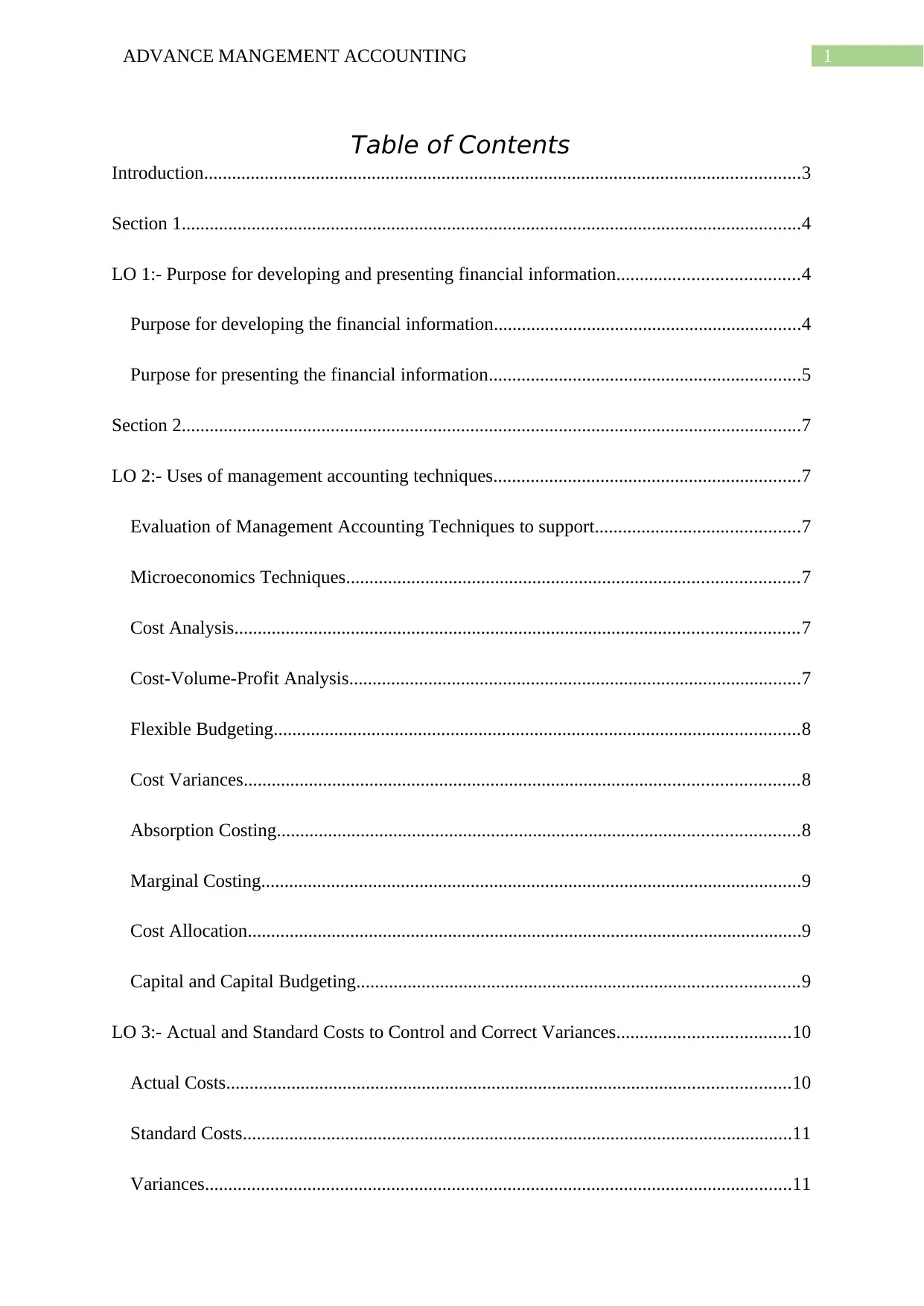
1ADVANCE MANGEMENT ACCOUNTING
Table of Contents
Introduction................................................................................................................................3
Section 1.....................................................................................................................................4
LO 1:- Purpose for developing and presenting financial information.......................................4
Purpose for developing the financial information..................................................................4
Purpose for presenting the financial information...................................................................5
Section 2.....................................................................................................................................7
LO 2:- Uses of management accounting techniques..................................................................7
Evaluation of Management Accounting Techniques to support............................................7
Microeconomics Techniques.................................................................................................7
Cost Analysis.........................................................................................................................7
Cost-Volume-Profit Analysis.................................................................................................7
Flexible Budgeting.................................................................................................................8
Cost Variances.......................................................................................................................8
Absorption Costing................................................................................................................8
Marginal Costing....................................................................................................................9
Cost Allocation.......................................................................................................................9
Capital and Capital Budgeting...............................................................................................9
LO 3:- Actual and Standard Costs to Control and Correct Variances.....................................10
Actual Costs.........................................................................................................................10
Standard Costs......................................................................................................................11
Variances..............................................................................................................................11
Table of Contents
Introduction................................................................................................................................3
Section 1.....................................................................................................................................4
LO 1:- Purpose for developing and presenting financial information.......................................4
Purpose for developing the financial information..................................................................4
Purpose for presenting the financial information...................................................................5
Section 2.....................................................................................................................................7
LO 2:- Uses of management accounting techniques..................................................................7
Evaluation of Management Accounting Techniques to support............................................7
Microeconomics Techniques.................................................................................................7
Cost Analysis.........................................................................................................................7
Cost-Volume-Profit Analysis.................................................................................................7
Flexible Budgeting.................................................................................................................8
Cost Variances.......................................................................................................................8
Absorption Costing................................................................................................................8
Marginal Costing....................................................................................................................9
Cost Allocation.......................................................................................................................9
Capital and Capital Budgeting...............................................................................................9
LO 3:- Actual and Standard Costs to Control and Correct Variances.....................................10
Actual Costs.........................................................................................................................10
Standard Costs......................................................................................................................11
Variances..............................................................................................................................11
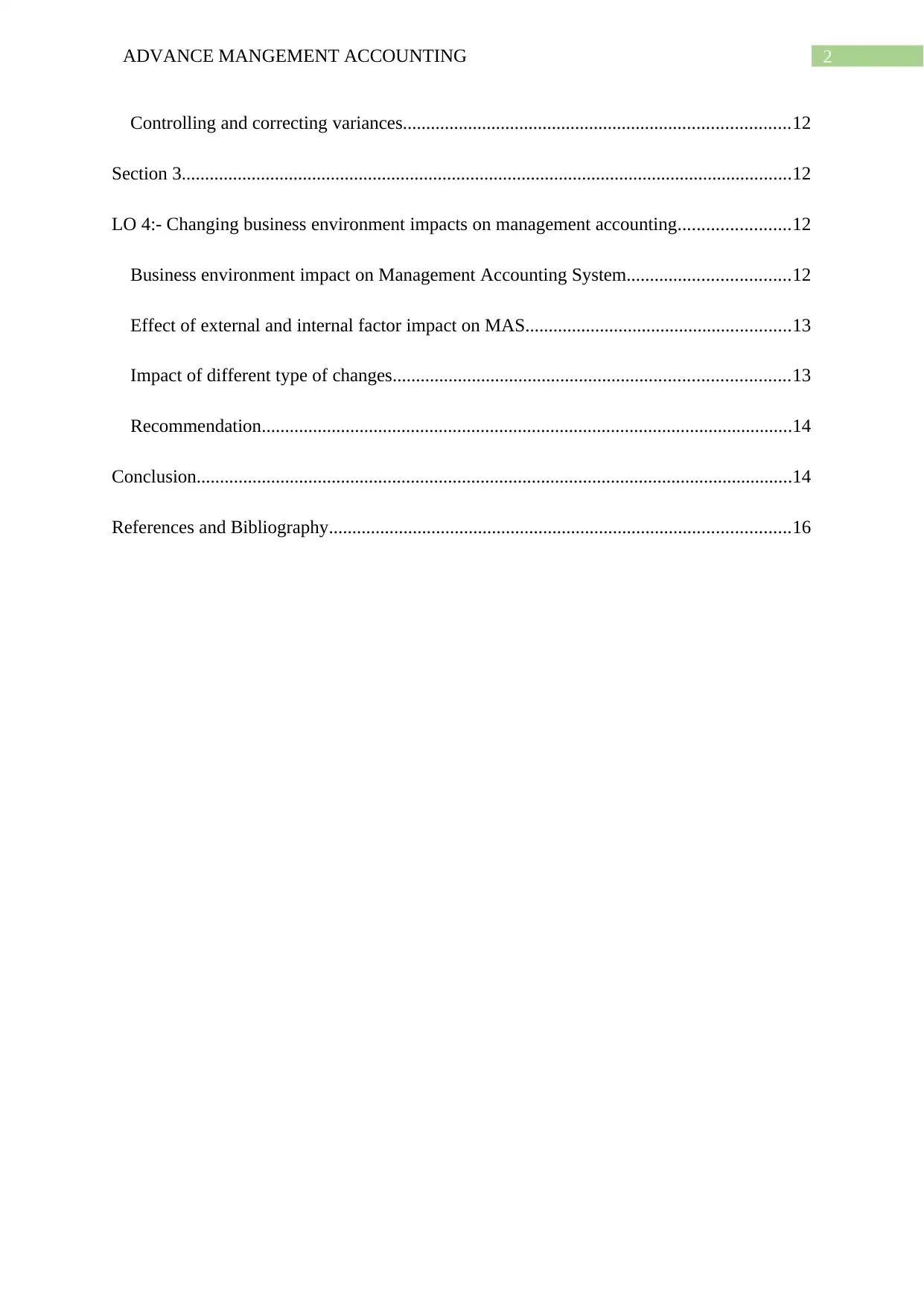
2ADVANCE MANGEMENT ACCOUNTING
Controlling and correcting variances...................................................................................12
Section 3...................................................................................................................................12
LO 4:- Changing business environment impacts on management accounting........................12
Business environment impact on Management Accounting System...................................12
Effect of external and internal factor impact on MAS.........................................................13
Impact of different type of changes.....................................................................................13
Recommendation..................................................................................................................14
Conclusion................................................................................................................................14
References and Bibliography...................................................................................................16
Controlling and correcting variances...................................................................................12
Section 3...................................................................................................................................12
LO 4:- Changing business environment impacts on management accounting........................12
Business environment impact on Management Accounting System...................................12
Effect of external and internal factor impact on MAS.........................................................13
Impact of different type of changes.....................................................................................13
Recommendation..................................................................................................................14
Conclusion................................................................................................................................14
References and Bibliography...................................................................................................16
⊘ This is a preview!⊘
Do you want full access?
Subscribe today to unlock all pages.

Trusted by 1+ million students worldwide
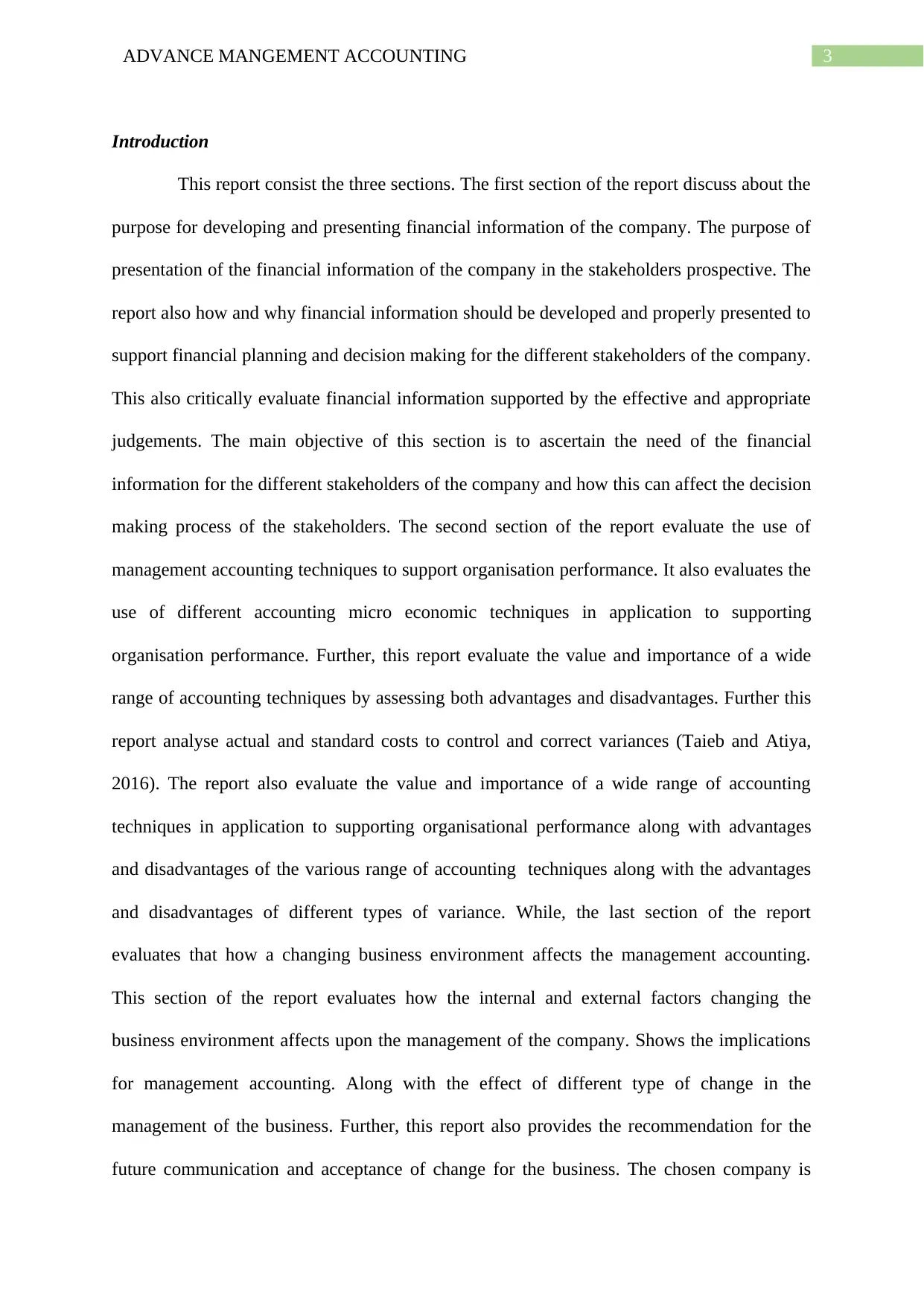
3ADVANCE MANGEMENT ACCOUNTING
Introduction
This report consist the three sections. The first section of the report discuss about the
purpose for developing and presenting financial information of the company. The purpose of
presentation of the financial information of the company in the stakeholders prospective. The
report also how and why financial information should be developed and properly presented to
support financial planning and decision making for the different stakeholders of the company.
This also critically evaluate financial information supported by the effective and appropriate
judgements. The main objective of this section is to ascertain the need of the financial
information for the different stakeholders of the company and how this can affect the decision
making process of the stakeholders. The second section of the report evaluate the use of
management accounting techniques to support organisation performance. It also evaluates the
use of different accounting micro economic techniques in application to supporting
organisation performance. Further, this report evaluate the value and importance of a wide
range of accounting techniques by assessing both advantages and disadvantages. Further this
report analyse actual and standard costs to control and correct variances (Taieb and Atiya,
2016). The report also evaluate the value and importance of a wide range of accounting
techniques in application to supporting organisational performance along with advantages
and disadvantages of the various range of accounting techniques along with the advantages
and disadvantages of different types of variance. While, the last section of the report
evaluates that how a changing business environment affects the management accounting.
This section of the report evaluates how the internal and external factors changing the
business environment affects upon the management of the company. Shows the implications
for management accounting. Along with the effect of different type of change in the
management of the business. Further, this report also provides the recommendation for the
future communication and acceptance of change for the business. The chosen company is
Introduction
This report consist the three sections. The first section of the report discuss about the
purpose for developing and presenting financial information of the company. The purpose of
presentation of the financial information of the company in the stakeholders prospective. The
report also how and why financial information should be developed and properly presented to
support financial planning and decision making for the different stakeholders of the company.
This also critically evaluate financial information supported by the effective and appropriate
judgements. The main objective of this section is to ascertain the need of the financial
information for the different stakeholders of the company and how this can affect the decision
making process of the stakeholders. The second section of the report evaluate the use of
management accounting techniques to support organisation performance. It also evaluates the
use of different accounting micro economic techniques in application to supporting
organisation performance. Further, this report evaluate the value and importance of a wide
range of accounting techniques by assessing both advantages and disadvantages. Further this
report analyse actual and standard costs to control and correct variances (Taieb and Atiya,
2016). The report also evaluate the value and importance of a wide range of accounting
techniques in application to supporting organisational performance along with advantages
and disadvantages of the various range of accounting techniques along with the advantages
and disadvantages of different types of variance. While, the last section of the report
evaluates that how a changing business environment affects the management accounting.
This section of the report evaluates how the internal and external factors changing the
business environment affects upon the management of the company. Shows the implications
for management accounting. Along with the effect of different type of change in the
management of the business. Further, this report also provides the recommendation for the
future communication and acceptance of change for the business. The chosen company is
Paraphrase This Document
Need a fresh take? Get an instant paraphrase of this document with our AI Paraphraser
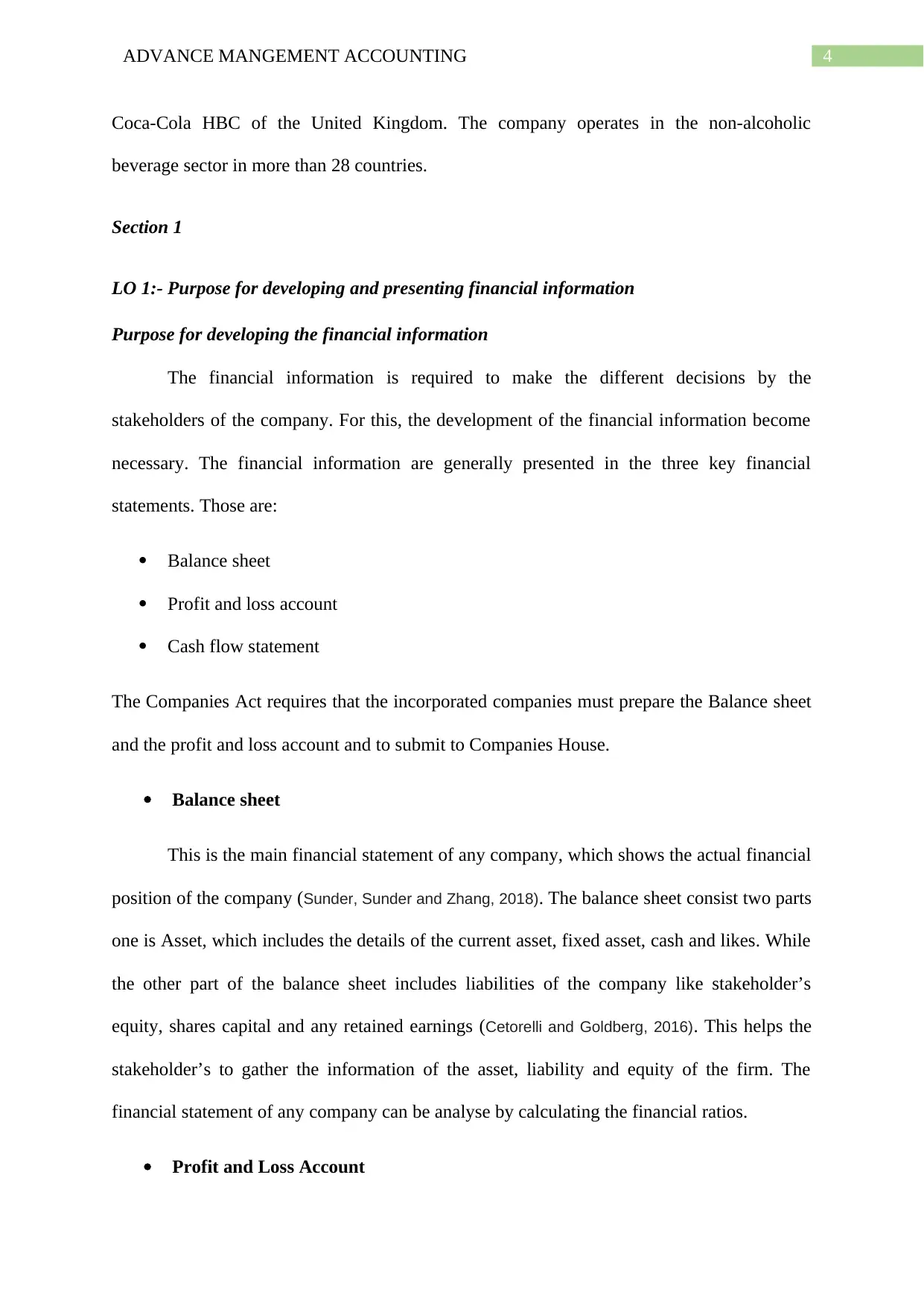
4ADVANCE MANGEMENT ACCOUNTING
Coca-Cola HBC of the United Kingdom. The company operates in the non-alcoholic
beverage sector in more than 28 countries.
Section 1
LO 1:- Purpose for developing and presenting financial information
Purpose for developing the financial information
The financial information is required to make the different decisions by the
stakeholders of the company. For this, the development of the financial information become
necessary. The financial information are generally presented in the three key financial
statements. Those are:
Balance sheet
Profit and loss account
Cash flow statement
The Companies Act requires that the incorporated companies must prepare the Balance sheet
and the profit and loss account and to submit to Companies House.
Balance sheet
This is the main financial statement of any company, which shows the actual financial
position of the company (Sunder, Sunder and Zhang, 2018). The balance sheet consist two parts
one is Asset, which includes the details of the current asset, fixed asset, cash and likes. While
the other part of the balance sheet includes liabilities of the company like stakeholder’s
equity, shares capital and any retained earnings (Cetorelli and Goldberg, 2016). This helps the
stakeholder’s to gather the information of the asset, liability and equity of the firm. The
financial statement of any company can be analyse by calculating the financial ratios.
Profit and Loss Account
Coca-Cola HBC of the United Kingdom. The company operates in the non-alcoholic
beverage sector in more than 28 countries.
Section 1
LO 1:- Purpose for developing and presenting financial information
Purpose for developing the financial information
The financial information is required to make the different decisions by the
stakeholders of the company. For this, the development of the financial information become
necessary. The financial information are generally presented in the three key financial
statements. Those are:
Balance sheet
Profit and loss account
Cash flow statement
The Companies Act requires that the incorporated companies must prepare the Balance sheet
and the profit and loss account and to submit to Companies House.
Balance sheet
This is the main financial statement of any company, which shows the actual financial
position of the company (Sunder, Sunder and Zhang, 2018). The balance sheet consist two parts
one is Asset, which includes the details of the current asset, fixed asset, cash and likes. While
the other part of the balance sheet includes liabilities of the company like stakeholder’s
equity, shares capital and any retained earnings (Cetorelli and Goldberg, 2016). This helps the
stakeholder’s to gather the information of the asset, liability and equity of the firm. The
financial statement of any company can be analyse by calculating the financial ratios.
Profit and Loss Account
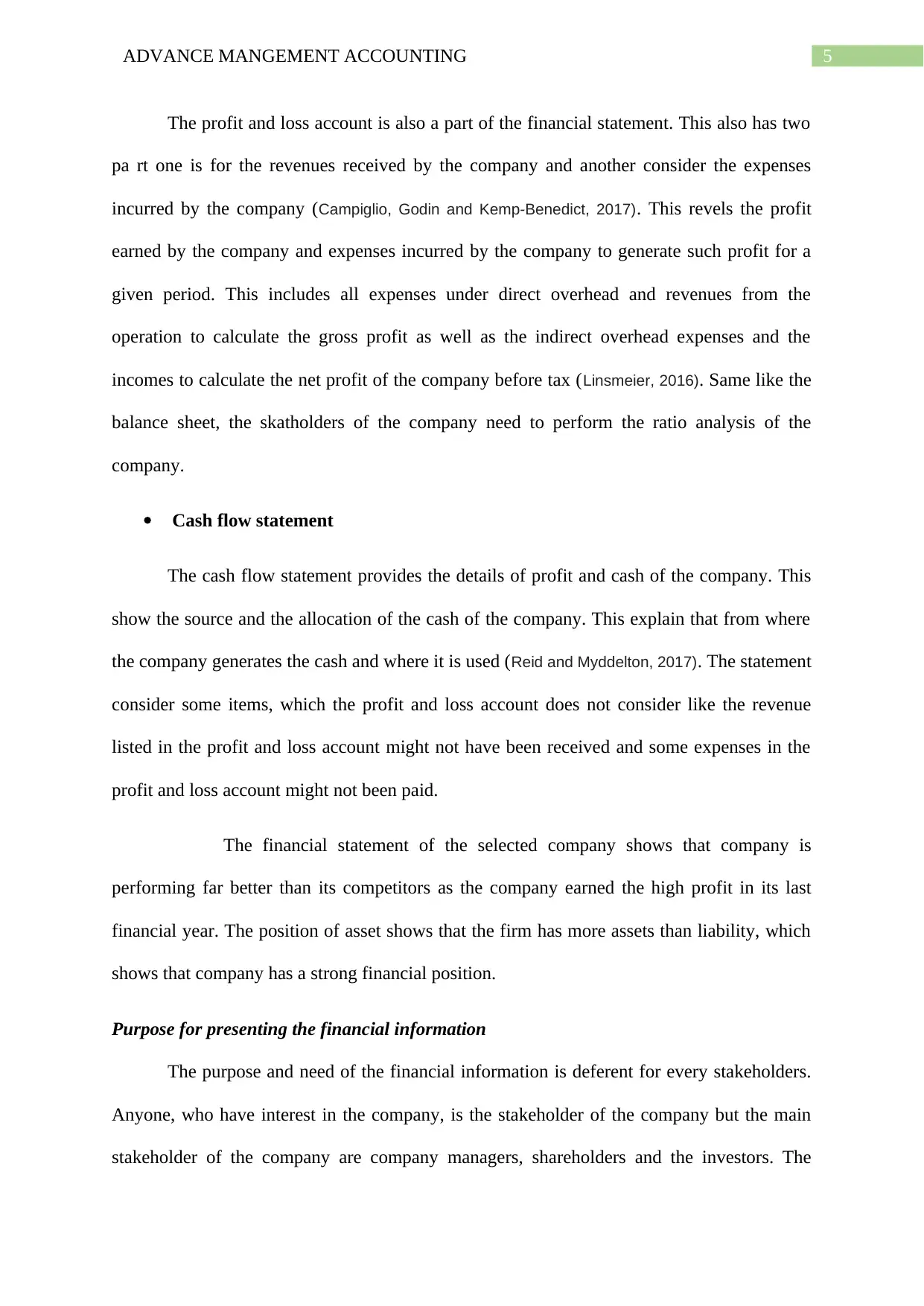
5ADVANCE MANGEMENT ACCOUNTING
The profit and loss account is also a part of the financial statement. This also has two
pa rt one is for the revenues received by the company and another consider the expenses
incurred by the company (Campiglio, Godin and Kemp-Benedict, 2017). This revels the profit
earned by the company and expenses incurred by the company to generate such profit for a
given period. This includes all expenses under direct overhead and revenues from the
operation to calculate the gross profit as well as the indirect overhead expenses and the
incomes to calculate the net profit of the company before tax (Linsmeier, 2016). Same like the
balance sheet, the skatholders of the company need to perform the ratio analysis of the
company.
Cash flow statement
The cash flow statement provides the details of profit and cash of the company. This
show the source and the allocation of the cash of the company. This explain that from where
the company generates the cash and where it is used (Reid and Myddelton, 2017). The statement
consider some items, which the profit and loss account does not consider like the revenue
listed in the profit and loss account might not have been received and some expenses in the
profit and loss account might not been paid.
The financial statement of the selected company shows that company is
performing far better than its competitors as the company earned the high profit in its last
financial year. The position of asset shows that the firm has more assets than liability, which
shows that company has a strong financial position.
Purpose for presenting the financial information
The purpose and need of the financial information is deferent for every stakeholders.
Anyone, who have interest in the company, is the stakeholder of the company but the main
stakeholder of the company are company managers, shareholders and the investors. The
The profit and loss account is also a part of the financial statement. This also has two
pa rt one is for the revenues received by the company and another consider the expenses
incurred by the company (Campiglio, Godin and Kemp-Benedict, 2017). This revels the profit
earned by the company and expenses incurred by the company to generate such profit for a
given period. This includes all expenses under direct overhead and revenues from the
operation to calculate the gross profit as well as the indirect overhead expenses and the
incomes to calculate the net profit of the company before tax (Linsmeier, 2016). Same like the
balance sheet, the skatholders of the company need to perform the ratio analysis of the
company.
Cash flow statement
The cash flow statement provides the details of profit and cash of the company. This
show the source and the allocation of the cash of the company. This explain that from where
the company generates the cash and where it is used (Reid and Myddelton, 2017). The statement
consider some items, which the profit and loss account does not consider like the revenue
listed in the profit and loss account might not have been received and some expenses in the
profit and loss account might not been paid.
The financial statement of the selected company shows that company is
performing far better than its competitors as the company earned the high profit in its last
financial year. The position of asset shows that the firm has more assets than liability, which
shows that company has a strong financial position.
Purpose for presenting the financial information
The purpose and need of the financial information is deferent for every stakeholders.
Anyone, who have interest in the company, is the stakeholder of the company but the main
stakeholder of the company are company managers, shareholders and the investors. The
⊘ This is a preview!⊘
Do you want full access?
Subscribe today to unlock all pages.

Trusted by 1+ million students worldwide
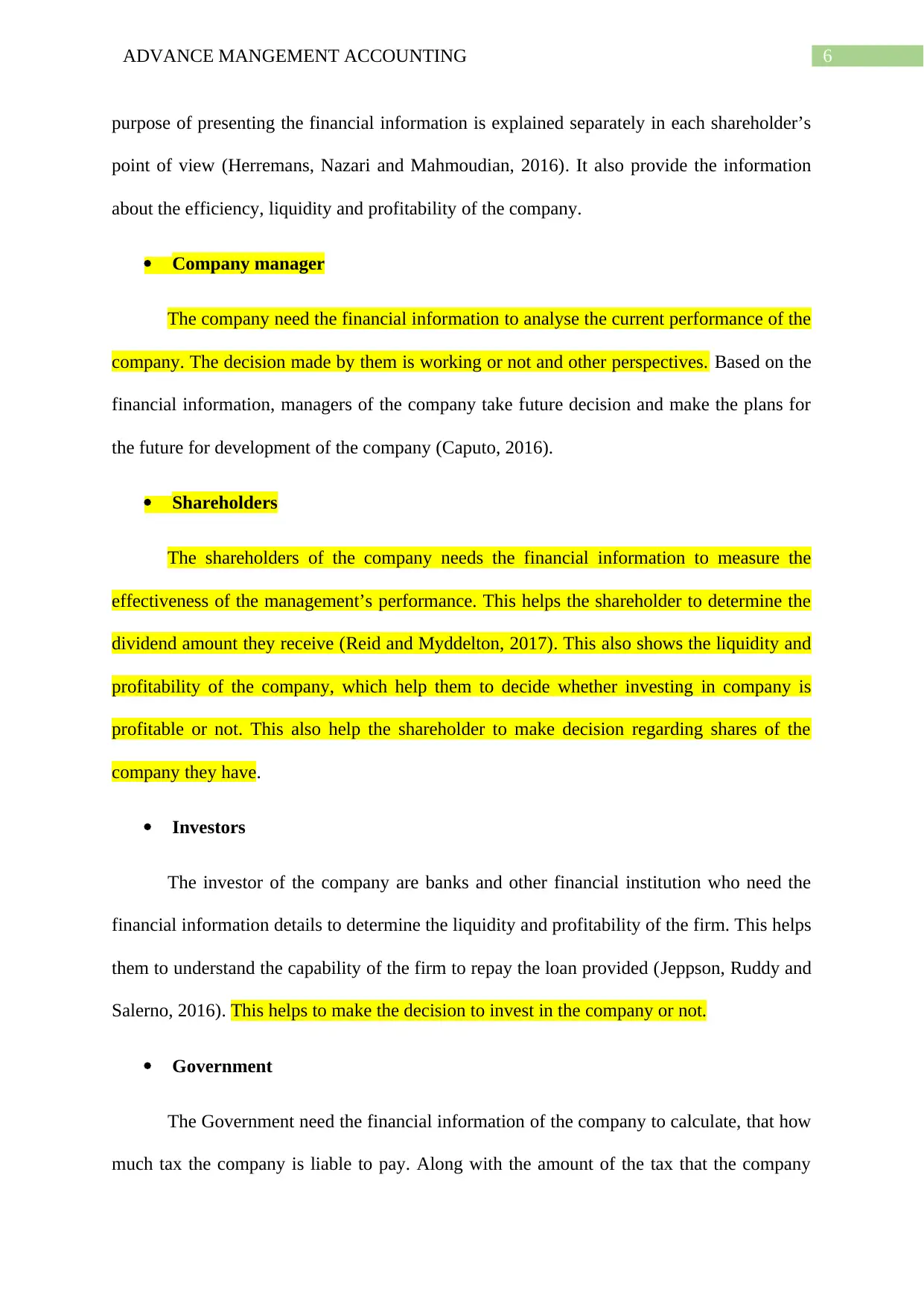
6ADVANCE MANGEMENT ACCOUNTING
purpose of presenting the financial information is explained separately in each shareholder’s
point of view (Herremans, Nazari and Mahmoudian, 2016). It also provide the information
about the efficiency, liquidity and profitability of the company.
Company manager
The company need the financial information to analyse the current performance of the
company. The decision made by them is working or not and other perspectives. Based on the
financial information, managers of the company take future decision and make the plans for
the future for development of the company (Caputo, 2016).
Shareholders
The shareholders of the company needs the financial information to measure the
effectiveness of the management’s performance. This helps the shareholder to determine the
dividend amount they receive (Reid and Myddelton, 2017). This also shows the liquidity and
profitability of the company, which help them to decide whether investing in company is
profitable or not. This also help the shareholder to make decision regarding shares of the
company they have.
Investors
The investor of the company are banks and other financial institution who need the
financial information details to determine the liquidity and profitability of the firm. This helps
them to understand the capability of the firm to repay the loan provided (Jeppson, Ruddy and
Salerno, 2016). This helps to make the decision to invest in the company or not.
Government
The Government need the financial information of the company to calculate, that how
much tax the company is liable to pay. Along with the amount of the tax that the company
purpose of presenting the financial information is explained separately in each shareholder’s
point of view (Herremans, Nazari and Mahmoudian, 2016). It also provide the information
about the efficiency, liquidity and profitability of the company.
Company manager
The company need the financial information to analyse the current performance of the
company. The decision made by them is working or not and other perspectives. Based on the
financial information, managers of the company take future decision and make the plans for
the future for development of the company (Caputo, 2016).
Shareholders
The shareholders of the company needs the financial information to measure the
effectiveness of the management’s performance. This helps the shareholder to determine the
dividend amount they receive (Reid and Myddelton, 2017). This also shows the liquidity and
profitability of the company, which help them to decide whether investing in company is
profitable or not. This also help the shareholder to make decision regarding shares of the
company they have.
Investors
The investor of the company are banks and other financial institution who need the
financial information details to determine the liquidity and profitability of the firm. This helps
them to understand the capability of the firm to repay the loan provided (Jeppson, Ruddy and
Salerno, 2016). This helps to make the decision to invest in the company or not.
Government
The Government need the financial information of the company to calculate, that how
much tax the company is liable to pay. Along with the amount of the tax that the company
Paraphrase This Document
Need a fresh take? Get an instant paraphrase of this document with our AI Paraphraser
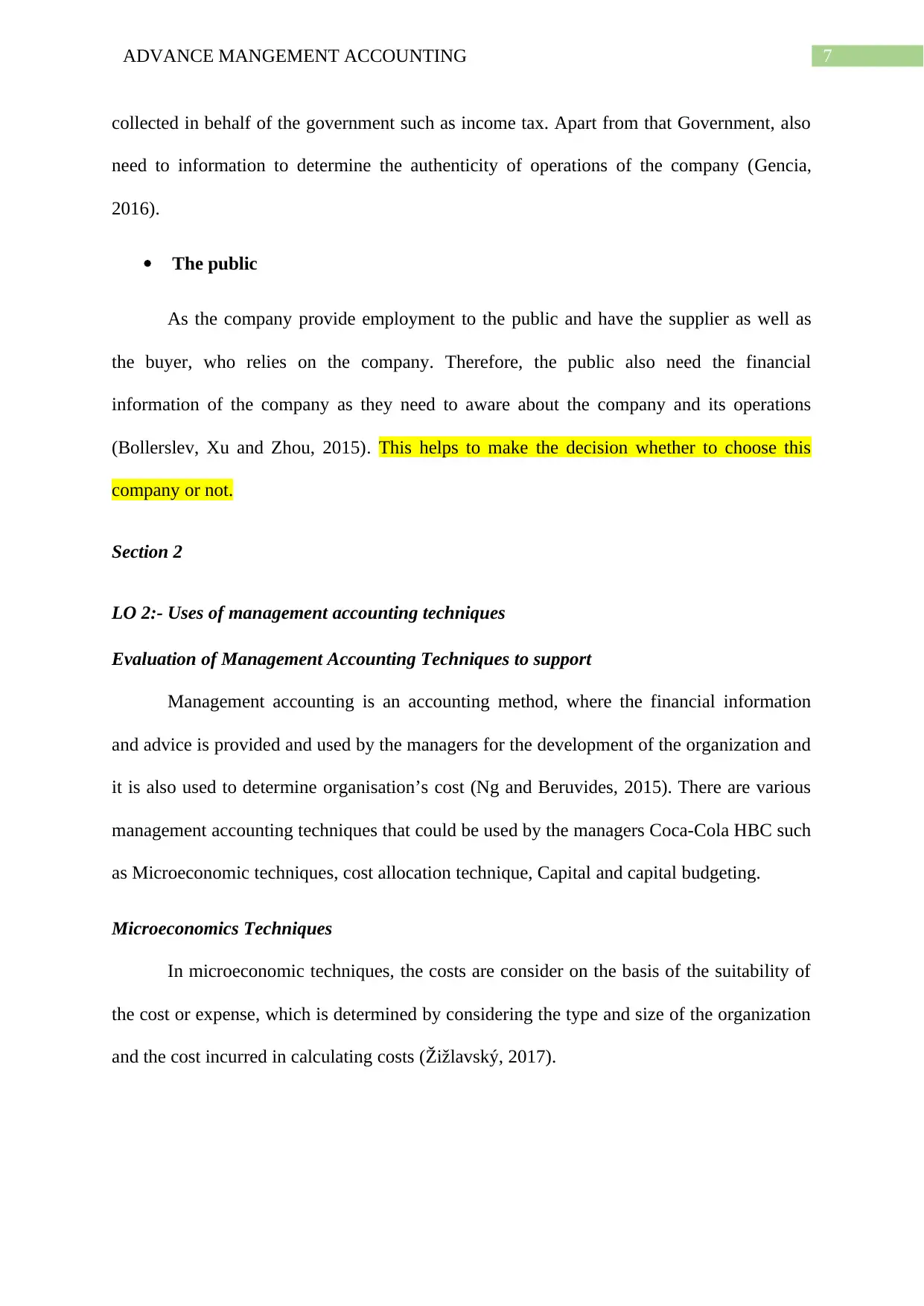
7ADVANCE MANGEMENT ACCOUNTING
collected in behalf of the government such as income tax. Apart from that Government, also
need to information to determine the authenticity of operations of the company (Gencia,
2016).
The public
As the company provide employment to the public and have the supplier as well as
the buyer, who relies on the company. Therefore, the public also need the financial
information of the company as they need to aware about the company and its operations
(Bollerslev, Xu and Zhou, 2015). This helps to make the decision whether to choose this
company or not.
Section 2
LO 2:- Uses of management accounting techniques
Evaluation of Management Accounting Techniques to support
Management accounting is an accounting method, where the financial information
and advice is provided and used by the managers for the development of the organization and
it is also used to determine organisation’s cost (Ng and Beruvides, 2015). There are various
management accounting techniques that could be used by the managers Coca-Cola HBC such
as Microeconomic techniques, cost allocation technique, Capital and capital budgeting.
Microeconomics Techniques
In microeconomic techniques, the costs are consider on the basis of the suitability of
the cost or expense, which is determined by considering the type and size of the organization
and the cost incurred in calculating costs (Žižlavský, 2017).
collected in behalf of the government such as income tax. Apart from that Government, also
need to information to determine the authenticity of operations of the company (Gencia,
2016).
The public
As the company provide employment to the public and have the supplier as well as
the buyer, who relies on the company. Therefore, the public also need the financial
information of the company as they need to aware about the company and its operations
(Bollerslev, Xu and Zhou, 2015). This helps to make the decision whether to choose this
company or not.
Section 2
LO 2:- Uses of management accounting techniques
Evaluation of Management Accounting Techniques to support
Management accounting is an accounting method, where the financial information
and advice is provided and used by the managers for the development of the organization and
it is also used to determine organisation’s cost (Ng and Beruvides, 2015). There are various
management accounting techniques that could be used by the managers Coca-Cola HBC such
as Microeconomic techniques, cost allocation technique, Capital and capital budgeting.
Microeconomics Techniques
In microeconomic techniques, the costs are consider on the basis of the suitability of
the cost or expense, which is determined by considering the type and size of the organization
and the cost incurred in calculating costs (Žižlavský, 2017).
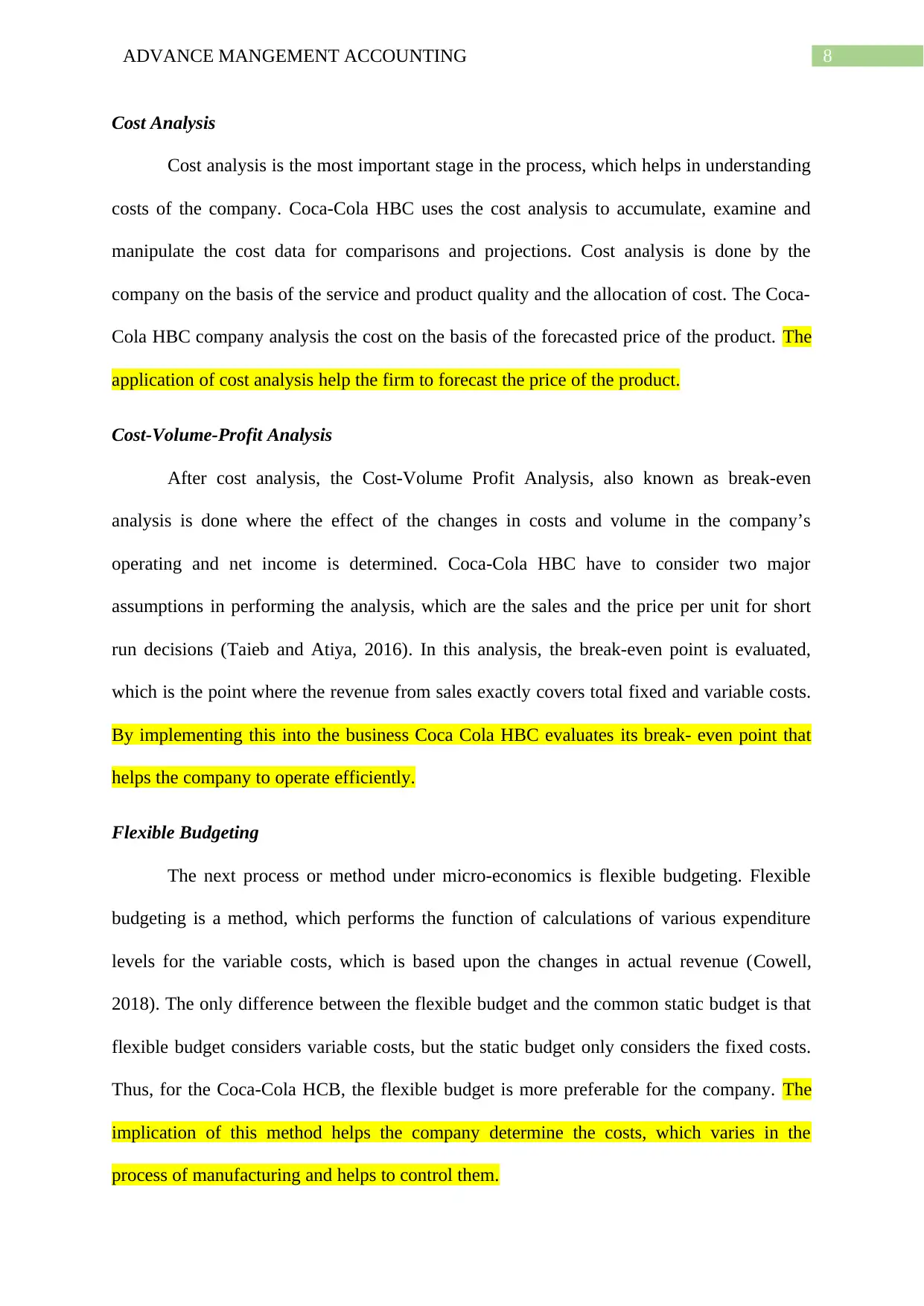
8ADVANCE MANGEMENT ACCOUNTING
Cost Analysis
Cost analysis is the most important stage in the process, which helps in understanding
costs of the company. Coca-Cola HBC uses the cost analysis to accumulate, examine and
manipulate the cost data for comparisons and projections. Cost analysis is done by the
company on the basis of the service and product quality and the allocation of cost. The Coca-
Cola HBC company analysis the cost on the basis of the forecasted price of the product. The
application of cost analysis help the firm to forecast the price of the product.
Cost-Volume-Profit Analysis
After cost analysis, the Cost-Volume Profit Analysis, also known as break-even
analysis is done where the effect of the changes in costs and volume in the company’s
operating and net income is determined. Coca-Cola HBC have to consider two major
assumptions in performing the analysis, which are the sales and the price per unit for short
run decisions (Taieb and Atiya, 2016). In this analysis, the break-even point is evaluated,
which is the point where the revenue from sales exactly covers total fixed and variable costs.
By implementing this into the business Coca Cola HBC evaluates its break- even point that
helps the company to operate efficiently.
Flexible Budgeting
The next process or method under micro-economics is flexible budgeting. Flexible
budgeting is a method, which performs the function of calculations of various expenditure
levels for the variable costs, which is based upon the changes in actual revenue (Cowell,
2018). The only difference between the flexible budget and the common static budget is that
flexible budget considers variable costs, but the static budget only considers the fixed costs.
Thus, for the Coca-Cola HCB, the flexible budget is more preferable for the company. The
implication of this method helps the company determine the costs, which varies in the
process of manufacturing and helps to control them.
Cost Analysis
Cost analysis is the most important stage in the process, which helps in understanding
costs of the company. Coca-Cola HBC uses the cost analysis to accumulate, examine and
manipulate the cost data for comparisons and projections. Cost analysis is done by the
company on the basis of the service and product quality and the allocation of cost. The Coca-
Cola HBC company analysis the cost on the basis of the forecasted price of the product. The
application of cost analysis help the firm to forecast the price of the product.
Cost-Volume-Profit Analysis
After cost analysis, the Cost-Volume Profit Analysis, also known as break-even
analysis is done where the effect of the changes in costs and volume in the company’s
operating and net income is determined. Coca-Cola HBC have to consider two major
assumptions in performing the analysis, which are the sales and the price per unit for short
run decisions (Taieb and Atiya, 2016). In this analysis, the break-even point is evaluated,
which is the point where the revenue from sales exactly covers total fixed and variable costs.
By implementing this into the business Coca Cola HBC evaluates its break- even point that
helps the company to operate efficiently.
Flexible Budgeting
The next process or method under micro-economics is flexible budgeting. Flexible
budgeting is a method, which performs the function of calculations of various expenditure
levels for the variable costs, which is based upon the changes in actual revenue (Cowell,
2018). The only difference between the flexible budget and the common static budget is that
flexible budget considers variable costs, but the static budget only considers the fixed costs.
Thus, for the Coca-Cola HCB, the flexible budget is more preferable for the company. The
implication of this method helps the company determine the costs, which varies in the
process of manufacturing and helps to control them.
⊘ This is a preview!⊘
Do you want full access?
Subscribe today to unlock all pages.

Trusted by 1+ million students worldwide
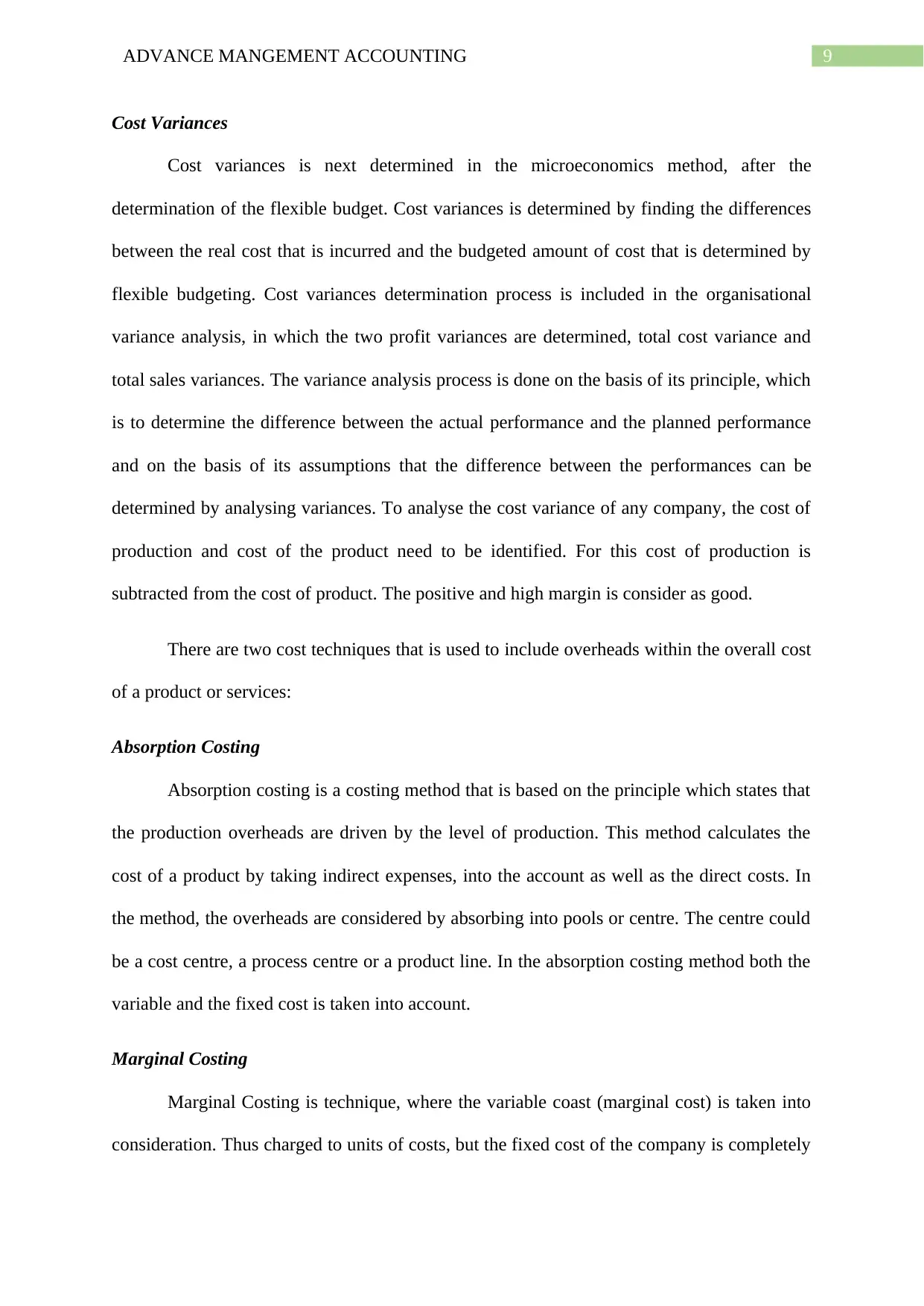
9ADVANCE MANGEMENT ACCOUNTING
Cost Variances
Cost variances is next determined in the microeconomics method, after the
determination of the flexible budget. Cost variances is determined by finding the differences
between the real cost that is incurred and the budgeted amount of cost that is determined by
flexible budgeting. Cost variances determination process is included in the organisational
variance analysis, in which the two profit variances are determined, total cost variance and
total sales variances. The variance analysis process is done on the basis of its principle, which
is to determine the difference between the actual performance and the planned performance
and on the basis of its assumptions that the difference between the performances can be
determined by analysing variances. To analyse the cost variance of any company, the cost of
production and cost of the product need to be identified. For this cost of production is
subtracted from the cost of product. The positive and high margin is consider as good.
There are two cost techniques that is used to include overheads within the overall cost
of a product or services:
Absorption Costing
Absorption costing is a costing method that is based on the principle which states that
the production overheads are driven by the level of production. This method calculates the
cost of a product by taking indirect expenses, into the account as well as the direct costs. In
the method, the overheads are considered by absorbing into pools or centre. The centre could
be a cost centre, a process centre or a product line. In the absorption costing method both the
variable and the fixed cost is taken into account.
Marginal Costing
Marginal Costing is technique, where the variable coast (marginal cost) is taken into
consideration. Thus charged to units of costs, but the fixed cost of the company is completely
Cost Variances
Cost variances is next determined in the microeconomics method, after the
determination of the flexible budget. Cost variances is determined by finding the differences
between the real cost that is incurred and the budgeted amount of cost that is determined by
flexible budgeting. Cost variances determination process is included in the organisational
variance analysis, in which the two profit variances are determined, total cost variance and
total sales variances. The variance analysis process is done on the basis of its principle, which
is to determine the difference between the actual performance and the planned performance
and on the basis of its assumptions that the difference between the performances can be
determined by analysing variances. To analyse the cost variance of any company, the cost of
production and cost of the product need to be identified. For this cost of production is
subtracted from the cost of product. The positive and high margin is consider as good.
There are two cost techniques that is used to include overheads within the overall cost
of a product or services:
Absorption Costing
Absorption costing is a costing method that is based on the principle which states that
the production overheads are driven by the level of production. This method calculates the
cost of a product by taking indirect expenses, into the account as well as the direct costs. In
the method, the overheads are considered by absorbing into pools or centre. The centre could
be a cost centre, a process centre or a product line. In the absorption costing method both the
variable and the fixed cost is taken into account.
Marginal Costing
Marginal Costing is technique, where the variable coast (marginal cost) is taken into
consideration. Thus charged to units of costs, but the fixed cost of the company is completely
Paraphrase This Document
Need a fresh take? Get an instant paraphrase of this document with our AI Paraphraser
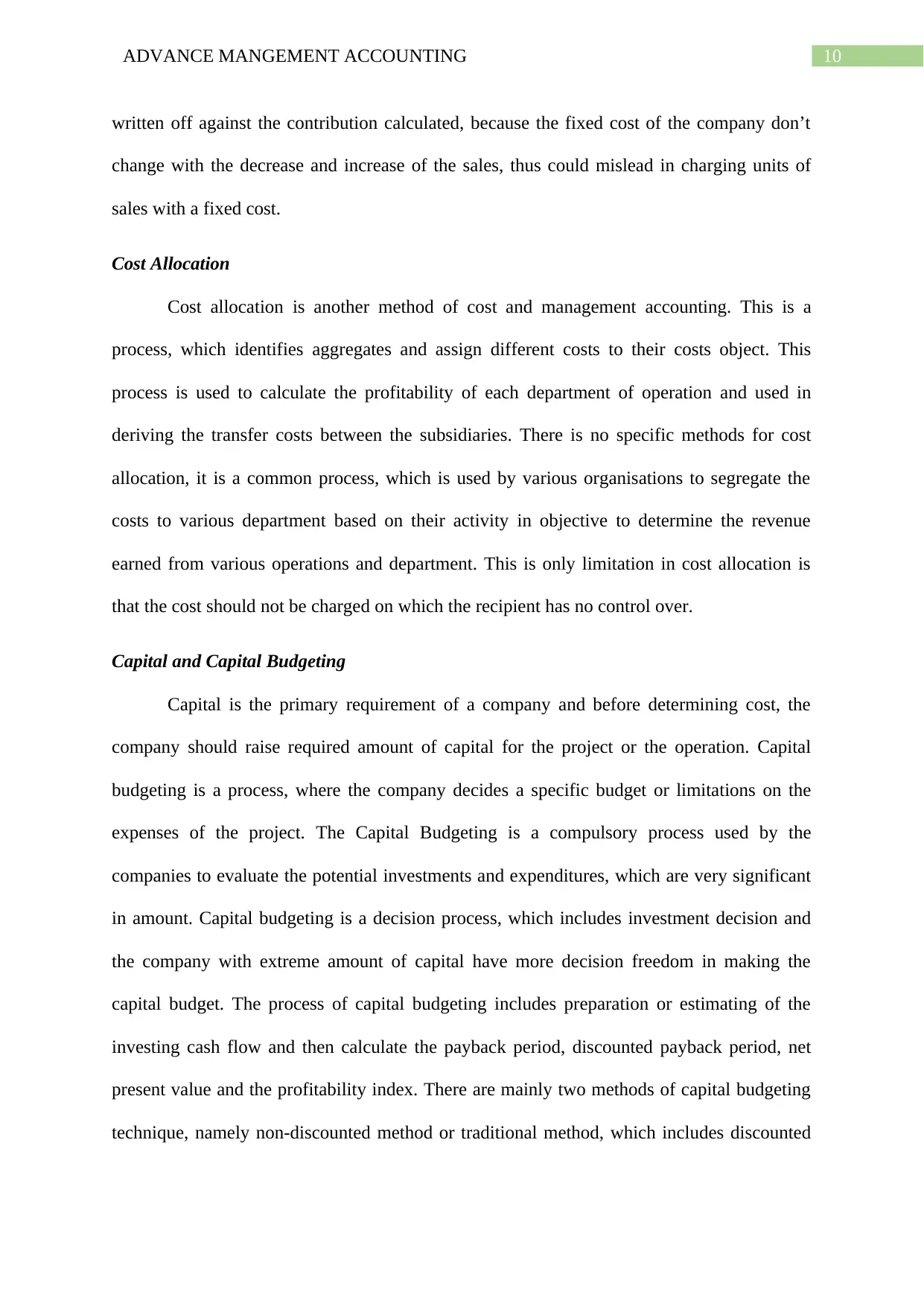
10ADVANCE MANGEMENT ACCOUNTING
written off against the contribution calculated, because the fixed cost of the company don’t
change with the decrease and increase of the sales, thus could mislead in charging units of
sales with a fixed cost.
Cost Allocation
Cost allocation is another method of cost and management accounting. This is a
process, which identifies aggregates and assign different costs to their costs object. This
process is used to calculate the profitability of each department of operation and used in
deriving the transfer costs between the subsidiaries. There is no specific methods for cost
allocation, it is a common process, which is used by various organisations to segregate the
costs to various department based on their activity in objective to determine the revenue
earned from various operations and department. This is only limitation in cost allocation is
that the cost should not be charged on which the recipient has no control over.
Capital and Capital Budgeting
Capital is the primary requirement of a company and before determining cost, the
company should raise required amount of capital for the project or the operation. Capital
budgeting is a process, where the company decides a specific budget or limitations on the
expenses of the project. The Capital Budgeting is a compulsory process used by the
companies to evaluate the potential investments and expenditures, which are very significant
in amount. Capital budgeting is a decision process, which includes investment decision and
the company with extreme amount of capital have more decision freedom in making the
capital budget. The process of capital budgeting includes preparation or estimating of the
investing cash flow and then calculate the payback period, discounted payback period, net
present value and the profitability index. There are mainly two methods of capital budgeting
technique, namely non-discounted method or traditional method, which includes discounted
written off against the contribution calculated, because the fixed cost of the company don’t
change with the decrease and increase of the sales, thus could mislead in charging units of
sales with a fixed cost.
Cost Allocation
Cost allocation is another method of cost and management accounting. This is a
process, which identifies aggregates and assign different costs to their costs object. This
process is used to calculate the profitability of each department of operation and used in
deriving the transfer costs between the subsidiaries. There is no specific methods for cost
allocation, it is a common process, which is used by various organisations to segregate the
costs to various department based on their activity in objective to determine the revenue
earned from various operations and department. This is only limitation in cost allocation is
that the cost should not be charged on which the recipient has no control over.
Capital and Capital Budgeting
Capital is the primary requirement of a company and before determining cost, the
company should raise required amount of capital for the project or the operation. Capital
budgeting is a process, where the company decides a specific budget or limitations on the
expenses of the project. The Capital Budgeting is a compulsory process used by the
companies to evaluate the potential investments and expenditures, which are very significant
in amount. Capital budgeting is a decision process, which includes investment decision and
the company with extreme amount of capital have more decision freedom in making the
capital budget. The process of capital budgeting includes preparation or estimating of the
investing cash flow and then calculate the payback period, discounted payback period, net
present value and the profitability index. There are mainly two methods of capital budgeting
technique, namely non-discounted method or traditional method, which includes discounted
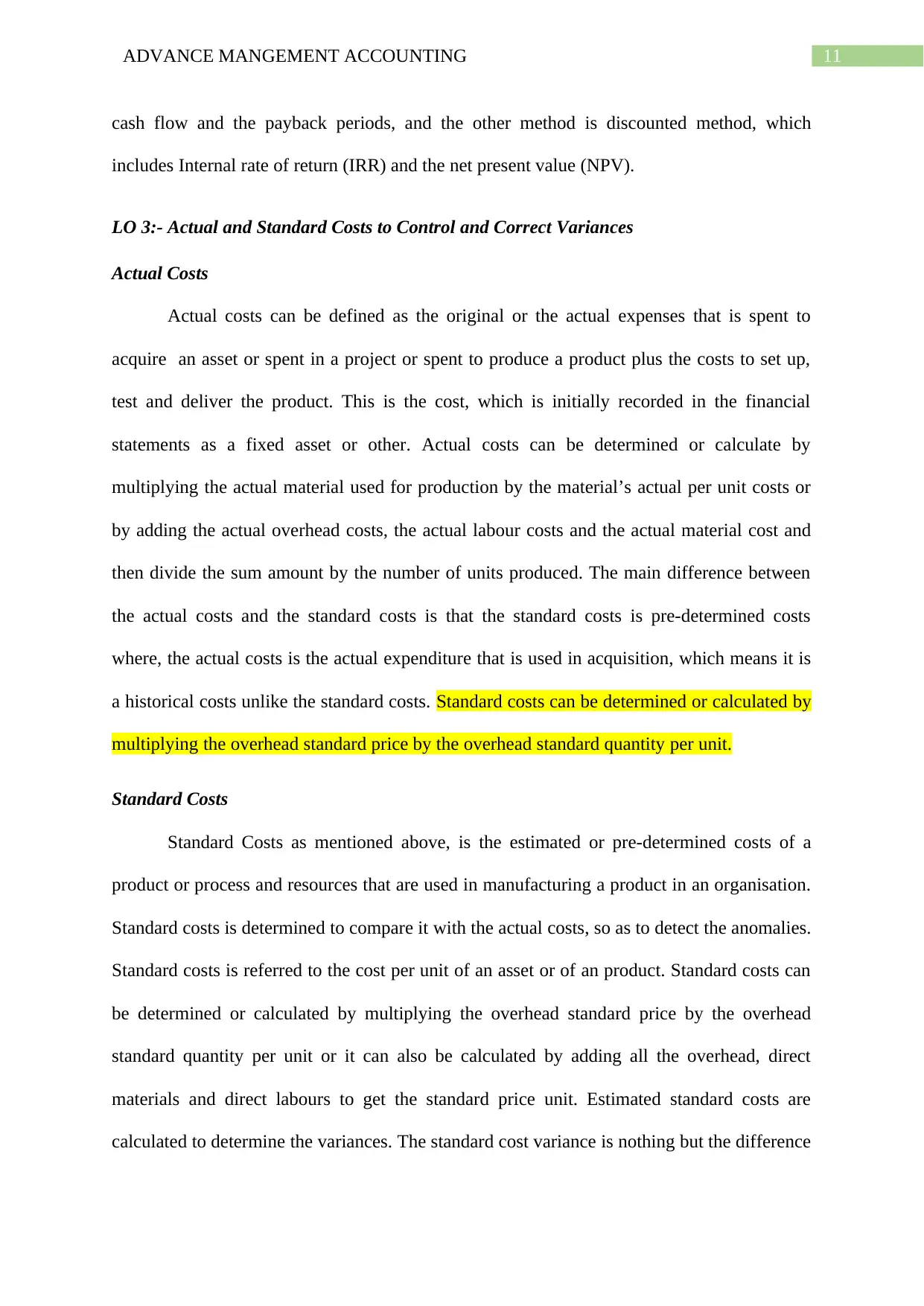
11ADVANCE MANGEMENT ACCOUNTING
cash flow and the payback periods, and the other method is discounted method, which
includes Internal rate of return (IRR) and the net present value (NPV).
LO 3:- Actual and Standard Costs to Control and Correct Variances
Actual Costs
Actual costs can be defined as the original or the actual expenses that is spent to
acquire an asset or spent in a project or spent to produce a product plus the costs to set up,
test and deliver the product. This is the cost, which is initially recorded in the financial
statements as a fixed asset or other. Actual costs can be determined or calculate by
multiplying the actual material used for production by the material’s actual per unit costs or
by adding the actual overhead costs, the actual labour costs and the actual material cost and
then divide the sum amount by the number of units produced. The main difference between
the actual costs and the standard costs is that the standard costs is pre-determined costs
where, the actual costs is the actual expenditure that is used in acquisition, which means it is
a historical costs unlike the standard costs. Standard costs can be determined or calculated by
multiplying the overhead standard price by the overhead standard quantity per unit.
Standard Costs
Standard Costs as mentioned above, is the estimated or pre-determined costs of a
product or process and resources that are used in manufacturing a product in an organisation.
Standard costs is determined to compare it with the actual costs, so as to detect the anomalies.
Standard costs is referred to the cost per unit of an asset or of an product. Standard costs can
be determined or calculated by multiplying the overhead standard price by the overhead
standard quantity per unit or it can also be calculated by adding all the overhead, direct
materials and direct labours to get the standard price unit. Estimated standard costs are
calculated to determine the variances. The standard cost variance is nothing but the difference
cash flow and the payback periods, and the other method is discounted method, which
includes Internal rate of return (IRR) and the net present value (NPV).
LO 3:- Actual and Standard Costs to Control and Correct Variances
Actual Costs
Actual costs can be defined as the original or the actual expenses that is spent to
acquire an asset or spent in a project or spent to produce a product plus the costs to set up,
test and deliver the product. This is the cost, which is initially recorded in the financial
statements as a fixed asset or other. Actual costs can be determined or calculate by
multiplying the actual material used for production by the material’s actual per unit costs or
by adding the actual overhead costs, the actual labour costs and the actual material cost and
then divide the sum amount by the number of units produced. The main difference between
the actual costs and the standard costs is that the standard costs is pre-determined costs
where, the actual costs is the actual expenditure that is used in acquisition, which means it is
a historical costs unlike the standard costs. Standard costs can be determined or calculated by
multiplying the overhead standard price by the overhead standard quantity per unit.
Standard Costs
Standard Costs as mentioned above, is the estimated or pre-determined costs of a
product or process and resources that are used in manufacturing a product in an organisation.
Standard costs is determined to compare it with the actual costs, so as to detect the anomalies.
Standard costs is referred to the cost per unit of an asset or of an product. Standard costs can
be determined or calculated by multiplying the overhead standard price by the overhead
standard quantity per unit or it can also be calculated by adding all the overhead, direct
materials and direct labours to get the standard price unit. Estimated standard costs are
calculated to determine the variances. The standard cost variance is nothing but the difference
⊘ This is a preview!⊘
Do you want full access?
Subscribe today to unlock all pages.

Trusted by 1+ million students worldwide
1 out of 20
Related Documents
Your All-in-One AI-Powered Toolkit for Academic Success.
+13062052269
info@desklib.com
Available 24*7 on WhatsApp / Email
![[object Object]](/_next/static/media/star-bottom.7253800d.svg)
Unlock your academic potential
Copyright © 2020–2025 A2Z Services. All Rights Reserved. Developed and managed by ZUCOL.





